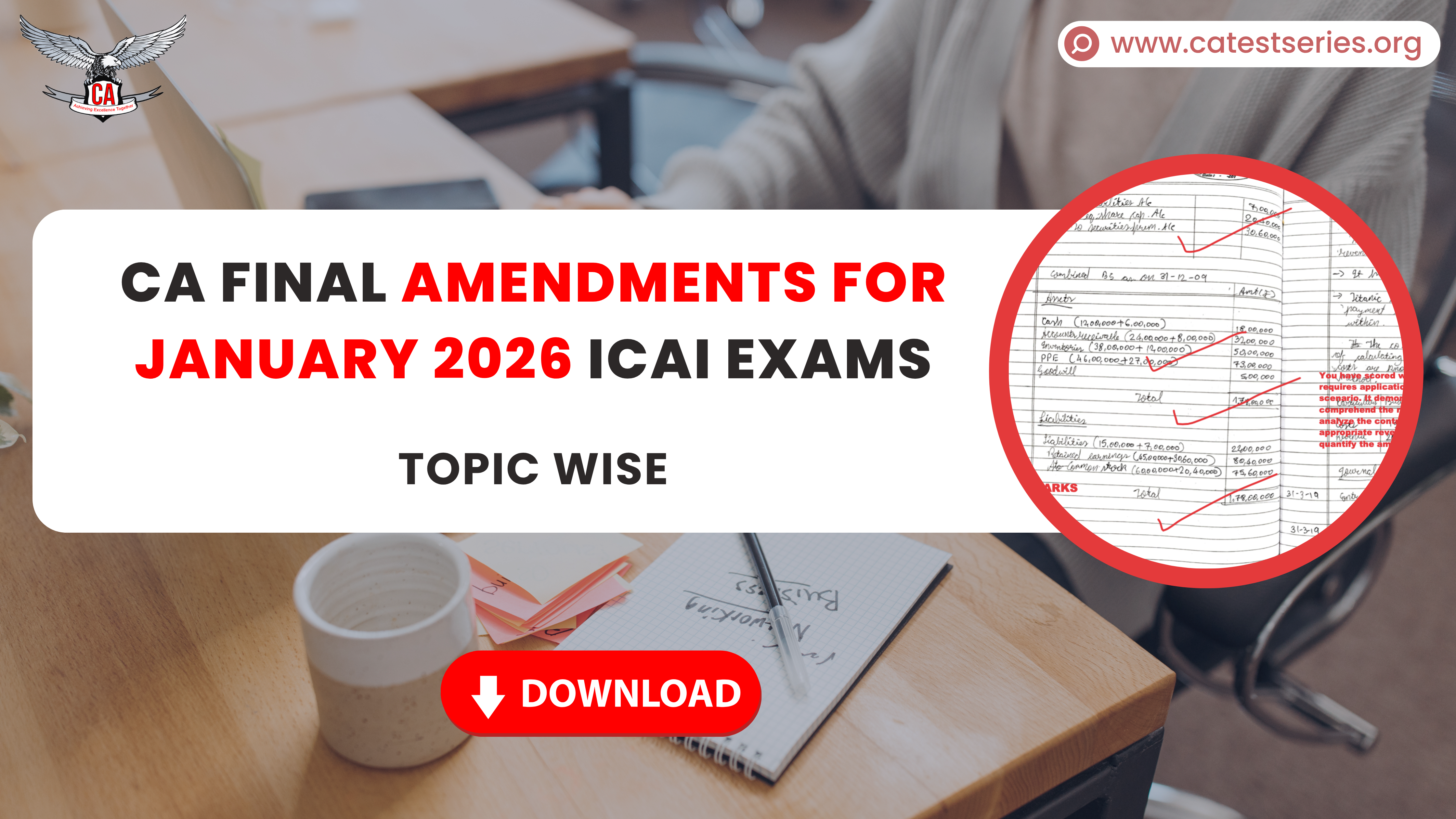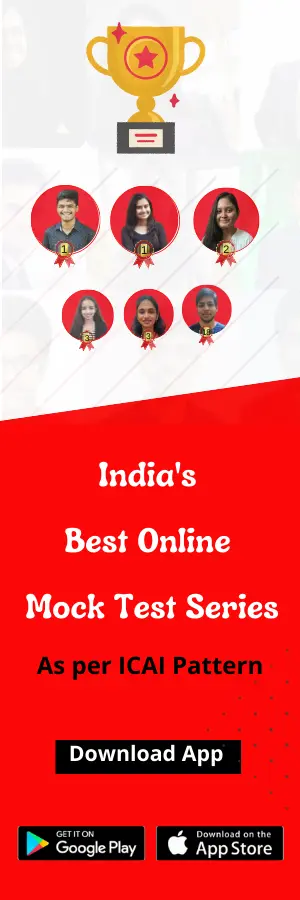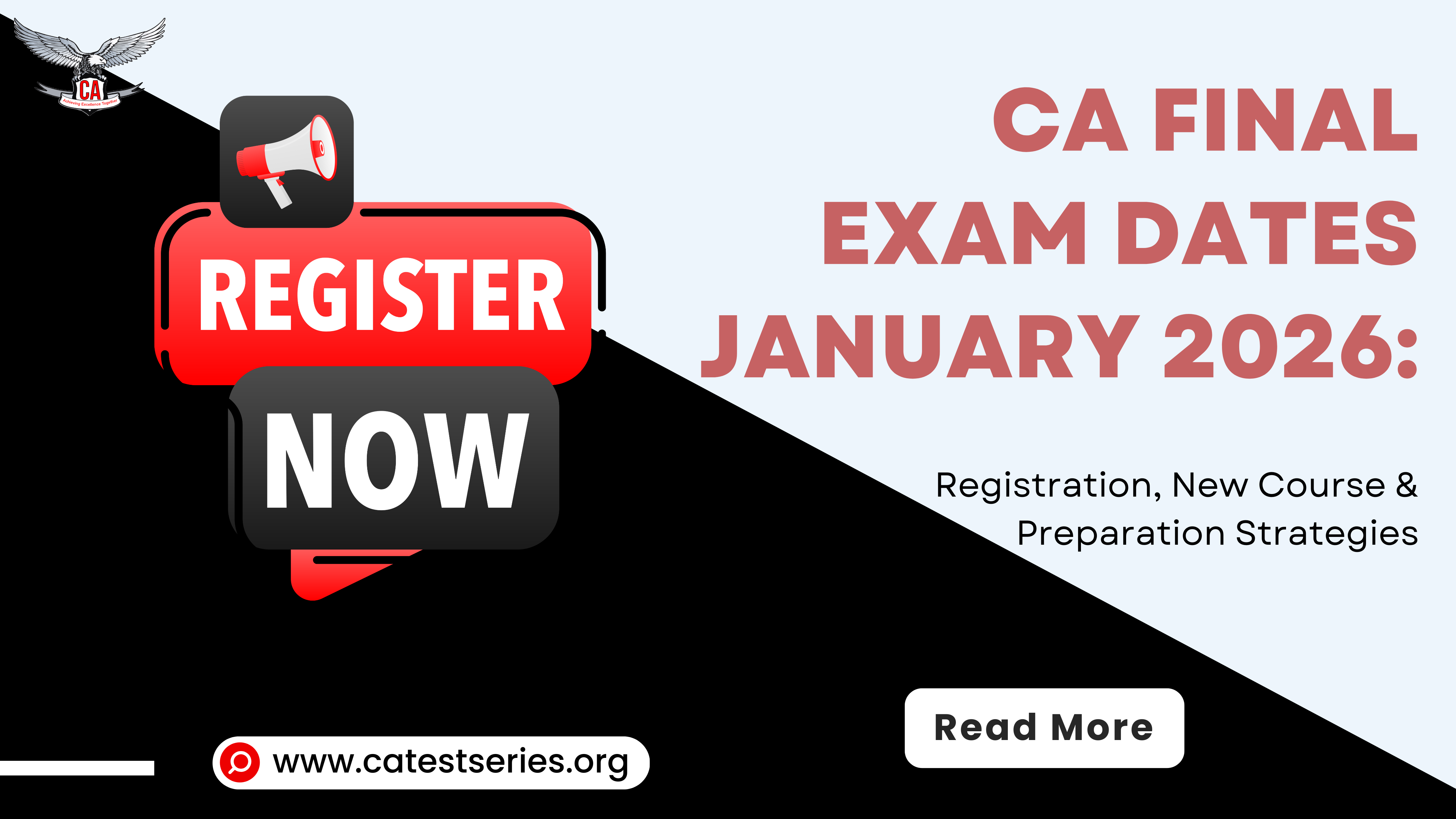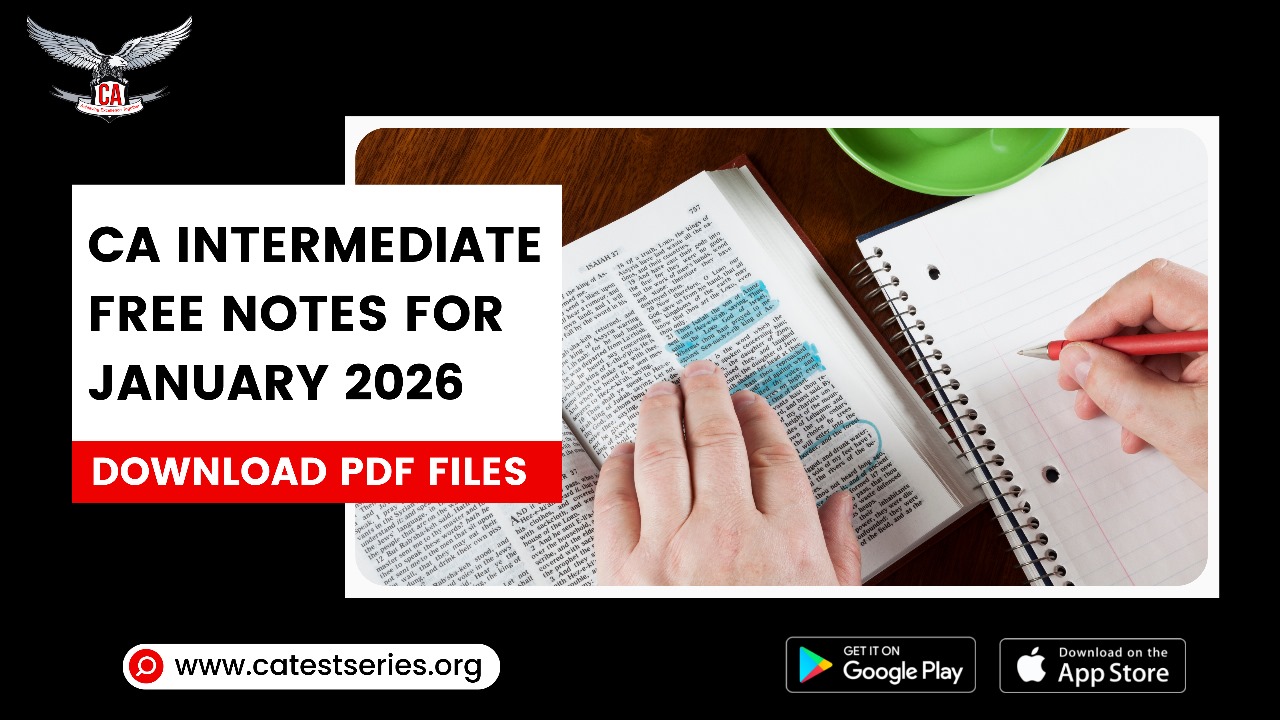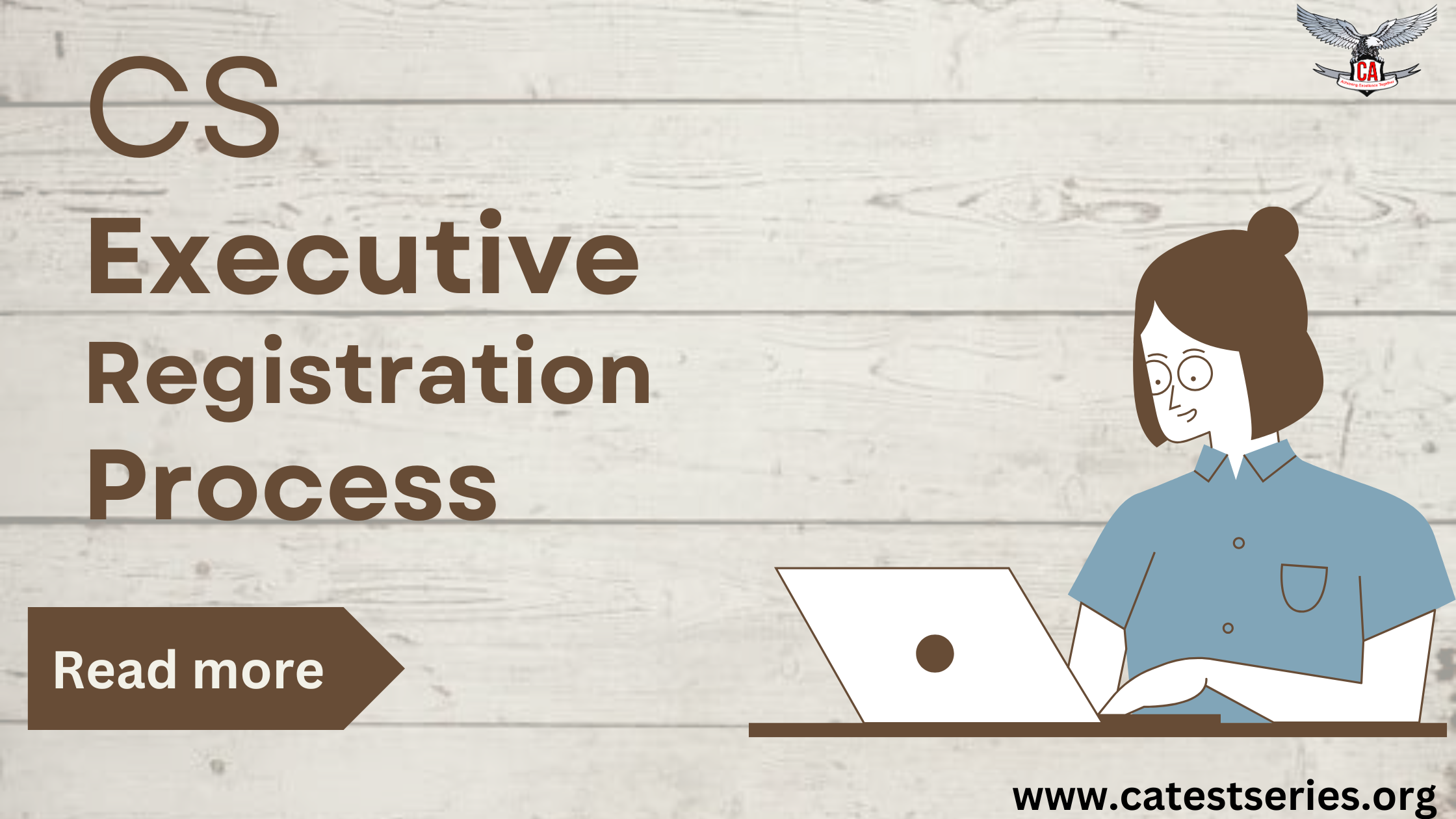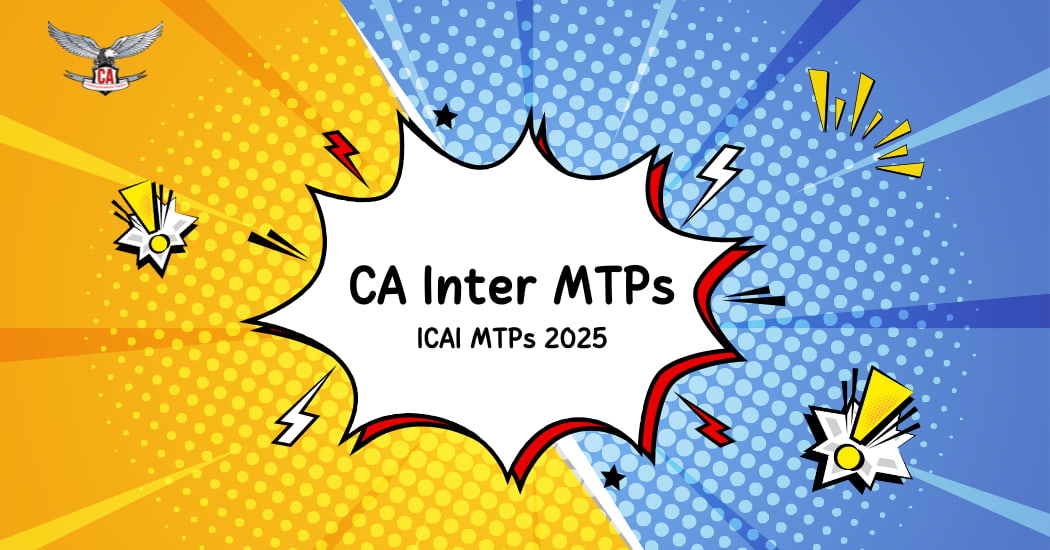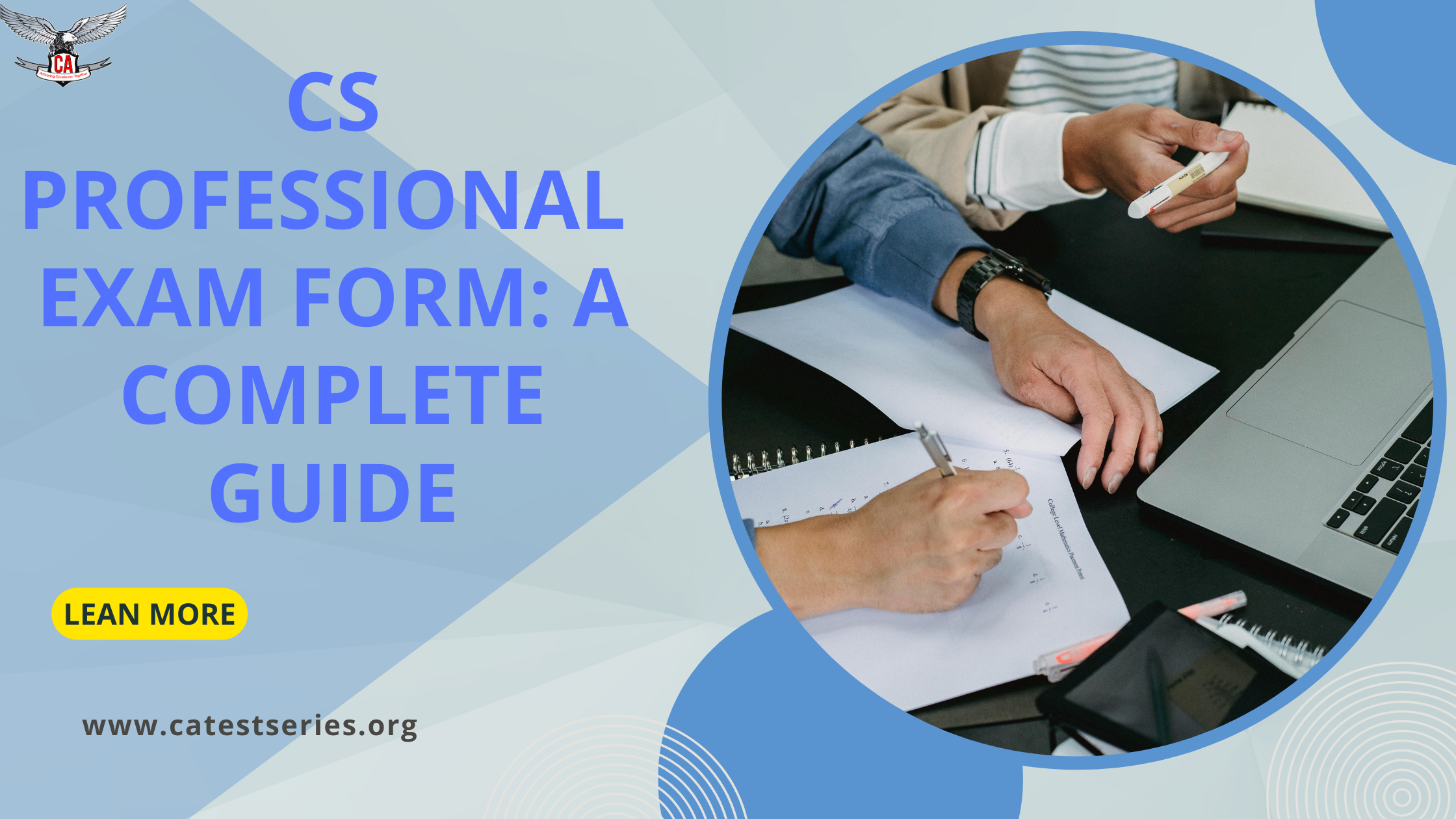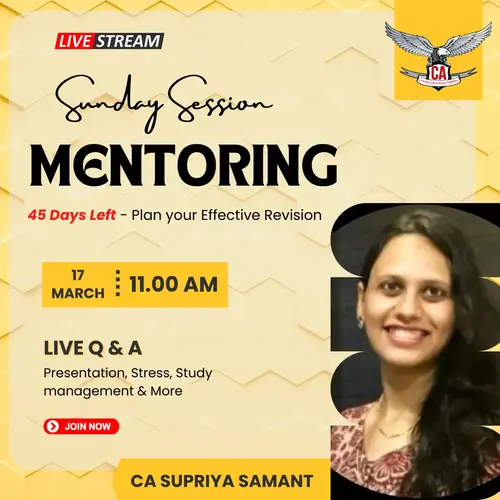CA Final Amendments for May 2025 ICAI Exams Topic Wise
Introduction
In order to bring the May 2025 ICAI tests into compliance with new regulations and industry practices, the CA Final amendments include major improvements in a number of topic areas. These changes guarantee that prospective chartered accountants are knowledgeable about the most recent updates to legislation, strategic financial management techniques, and financial reporting standards. The May 2025 ICAI exams will have significant revisions in a number of disciplines according to the CA Final modifications. A revision to Ind AS 115 concerning revenue recognition from client contracts may be found in Financial Reporting. New rules on bitcoin transactions and their financial ramifications are shown in Strategic Financial Management. Changes to the 2016 Insolvency and Bankruptcy Code are included in the Corporate and Economic Laws section, with a focus on cross-border insolvency. A greater comprehension of forensic accounting and fraud detection is increasingly necessary for advanced auditing and professional ethics. While indirect tax laws have updated GST regulations with an emphasis on e-invoicing and compliance, direct tax laws have amended tax slabs and exemptions. These updates are crucial for maintaining the relevance and rigor of the CA qualification.
Check All the amendments for CA Final May 2025 Attempt in Detail
Financial Reporting (Relevant for May 2025 examinations) | |
Advanced Financial management (AFM) | |
Advanced Auditing and Professional Ethics | |
Integrated Business Solution (Multi-disciplinary case study with Strategic management ) | |
Indirect Tax Laws (Relevant for May 2025 examinations) | |
Direct Tax and International Taxation (Relevant for May 2025 examinations) | Download |
Amendments in CA Final Advanced Audit & Professional Ethics
Amendment notes of CA Final audit
CHAPTER 5.3: CARO 2020
Amendment in: Definition of small Company
Not Applicable to: | Insurance Company Banking Company Private Company (Not being a subsidiary or holding company of public company) Below all condition need to be fulful Company U/s 8 of Co. Act 2013 OPC and small Company under Co. Act - Small Company: 2(85) of Co. Act 2013, other than a public company: (1) Paid up S/c less than or equal to Rs. 4 crores, AND (2) Turnover less than or equal to Rs. 40 crores (Imm . preceding FY) (Further, it should not be, Holding or Subsidiary of any Company
• CARO shall not apply to the auditors report on consolidated financial statements except Para 3(xxi). |
CHAPTER 11: NBFC
2) Infrastructure Finance Company (IFC): A company which has net owned funds of at least ₹ 300 crore and has deployed 75% of its total assets in Infrastructure loans is called IFC provided it has credit rating of A or above and has a CRAR of 15% (with a minimum Tier I capital of 10 %).
3) Systemically Important Core Investment Company (CIC-ND-SI): Core Investment Companies (CIC) having total assets of not less than ₹ 100 crores either individually or in aggregate along with other CICs in the group and which raises or holds public funds are called as Systemically Important Core Investment Companies (CICs-ND-SI).
4) Infrastructure Debt Fund (IDF-NBFC): IDF-NBFC means a non-deposit taking Non-Banking Financial Company that has:
a) net owned funds of ₹ 300 crore or more; and
b) which invests only in Public Private Partnerships (PPP) and post commencement operations date (COD) infrastructure projects which have completed at least one year of satisfactory commercial operation and becomes a party to a Tripartite Agreement
5) Non-Banking Financial Company – Micro Finance Institution (NBFC-MFI): NBFC-MFI is a non- deposit taking NBFC which has at least 85% of its assets in the form of microfinance. Such microfinance should be in the form of loan given to those who have annual income of ₹ 1,00,000 in rural areas and ₹ 160,000 in urban or semi urban areas. Such loans should not exceed ₹ 1,00,000 and its tenure should not be less than 24 months. Further, the loan has to be given without collateral. Loan repayment is done on weekly, fortnightly or monthly installments at the choice of the borrower
- Four Layers of NBFCs – Scale Based Regulation (SBR):
Effective from 01 October 2022: RBI has revised different facets of existing NBFC Classification and regulation like Capital Requirements, Governance Standards, Prudential Regulations, etc. based on four layers that are defined based on their size, activity, and perceived riskiness:
1) Base Layer (NBFC-BL): | a) NBFC – ND : asset size < ₹1000 crore and b) NBFC undertaking the following activities- (i) NBFC-Peer to Peer Lending Platform (NBFC-P2P), [online mediator to Lender & borrower] (ii) NBFC-Account Aggregator (NBFC-AA), [accumulate & distribute F.I. of Persons] (iii) Non-Operative Financial Holding Company (NOFHC) and (iv) NBFCs not availing public funds and not having any customer interface. |
2) Middle Layer (NBFC-ML), | a) NBFC-D, irrespective of asset size, [Can be in Mid Layer Or Upper] b) NBFC – ND, with asset size ≥ ₹1000 crore and c) NBFCs undertaking the following activities (i) Standalone Primary Dealers (SPDs), [authorized in buying and selling govt. securities – will Always remain in MID LAYER] (ii) Infrastructure Debt Fund - NBFC (IDF-NBFCs), [Will Always remain in MID LAYER] (iii) Core Investment Companies (CICs), [Can be in Mid Layer Or Upper] (iv) Housing Finance Companies (HFCs) and [Can be in Mid Layer Or Upper] (v) Infrastructure Finance Companies (NBFC-IFCs). [Can be in Mid Layer Or Upper] |
3) Upper Layer (NBFC-UL) | These are specifically identified by the RBI as warranting enhanced regulatory requirement based on a set of parameters and scoring methodology (as per Circular). The top 10 eligible NBFCs in terms of their asset size shall always reside in the upper layer, irrespective of any other factor |
4) Top Layer (NBFC-TL) |
|
- NBFCs like, viz., Investment and Credit Companies (NBFC-ICC), Micro Finance Institution (NBFC-MFI), NBFCFactors and Mortgage Guarantee Companies (NBFC-MGC) could lie in any of the layers of the regulatory structure depending on the parameters of the scale based regulatory framework. | |
- Government owned NBFCs shall be placed in the Base Layer or Middle Layer, as the case may be. They will not be placed in the Upper Layer till further notice.
DIFFERENCES BETWEEN BANKS AND NBFCS
Basis | NBFC | Bank |
Demand Deposit | NBFC cannot accept demand deposits, however some NBFCs can accept Term Deposits | Can accept |
Cheque | No, NBFCs do not form part of the payment and settlement system and cannot issue cheques drawn on itself; | Yes |
DICGC | No, deposit insurance facility of Deposit Insurance and Credit Guarantee Corporation (DICGC) is not available to depositors | Yes |
Priority Sector | No Minimum Exposure to Priority Sector required by NBFCs | Yes |
PRUDENTIAL NORMS
Capital Requirements: 𝑪𝒂𝒑𝒊𝒕𝒂𝒍 𝑨𝒔𝒔𝒆𝒕𝒔 ∗ 𝑹𝒊𝒔𝒌 𝑾𝒆𝒊𝒈𝒉𝒕 | NBFC : SI (Sys. Imp) – Deposit & Non Deposit taking:
| |||||||||||||||||||||||
Income Recognition: | The income recognition shall be based on recognised accounting principles.
| |||||||||||||||||||||||
Asset Classification & Provisioning Norms: | The asset classification & Provisioning norms as given below shall apply to every applicable NBFC (except NBFC-MFIs): Note: The class of assets referred to above shall not be upgraded merely as a result of rescheduling, unless it satisfies the conditions required for the upgradation
|
Chapter – 16 : Unit 3: Forensic Accounting (Earlier Forensic Audit)
The word “Forensic Audit” in this Chapter including the name of Unit 3 stands changed to Forensic Accounting.
All the references to “Forensic Audit” throughout the study material shall stand changed to Forensic Accounting.
Similarly, Forensic Auditor should also be read as Forensic Accountant.
CHAPTER 17.1 : Peer Review
The Word “Statement” or “Statement on Peer Review” used throughout the chapter shall be substituted as “Guidelines” or “Peer Review Guidelines, 2022” respectively
1) The words “Technical, Professional and Ethical Standards as applicable including other regulatory requirements thereto and” shall be substituted with “Technical, Professional and Ethical Standards as applicable including Audit Quality Maturity Model wherever applicable or any other regulatory requirements as may be prescribed by the Council or any Committee and”
Definition as Per ICAI:
"Peer Review" means an examination and review of the systems and procedures to determine whether the same have been put in place by the Practice Unit for ensuring the quality of assurance services as envisaged by the Technical, Professional and Ethical Standards as applicable including Audit Quality Maturity Model wherever applicable or any other regulatory requirements as may be prescribed by the Council or any Committee."
What are the objectives of Peer Review?
Answer:
Ensure that in carrying out the assurance service assignments, the members of the Institute:
- Comply with the Technical, Professional and Ethical Standards as applicable including Audit Quality Maturity Model wherever applicable or any other regulatory requirements as may be prescribed by the Council or any Committee
- have in place proper systems including documentation thereof, to amply demonstrate the quality of the assurance services
2) Some Changes in Definition & Additions
Reviewer: [Clause 2(19)] | means a member duly approved and empanelled by the Board on fulfilling the qualifications prescribed for a Reviewer as per Guideline 26 of these Guidelines [Clause 2(19) of Peer Review Guidelines, 2022] |
New Unit: [Clause 2 (12)] | • Firm whose date of establishment is less than 12 months immediately preceding the date of receipt of application of Peer Review and which may or may not have rendered any assurance service during the said period or • Practice Unit in existence for a period exceeding 12 months but not rendering any assurance services. |
Branch Peer Reviewer [2(9)] | Means a Reviewer appointed to conduct the Peer Review of the Branch of a Practice Unit. The qualifications and other obligations and duties of the Branch Peer Reviewer shall be the same as that of the Reviewer [Clause 2 (5) of PRG, 2022] |
Clause 1, Part 2 CAAct: | The Peer Review Guidelines, 2022 issued by Council are covered under clause (1) of Part II of Second Schedule to the Act and it is obligatory for the Practice Unit to comply with the provisions contained in this Guidelines. |
3) One point Added in Scope
Scope:
| Q. Write short note on scope of peer review. Answer: The Peer Review process shall apply to all the assurance services provided by a Practice Unit. 1) Once a Practice Unit is selected for Review, its assurance engagement records pertaining to the Peer Review Period shall be subjected to Review 2) The Review shall cover: (i) Compliance with Technical, Professional and Ethical Standards (ii) Compliance with directions and/or guidelines issued by the Council to the Members, including Fees to be charged, Number of audits undertaken, register for Assurance Engagements conducted during the year and such other related records. (iii) Compliance with directions and/or guidelines issued by the Council in relating to article assistants and/or audit assistants, including attendance register, work diaries, stipend payments, and such other related records (iv) Systems and procedures for carrying out assurance services. (v) Training programmes for staff (including articled and audit assistants) concerned with assurance functions, including availability of appropriate infrastructure. (vi) Self-evaluation under Audit Quality Maturity Model or any other guideline issued the Centre for Audit Quality by (vii) Quality of reporting |
4) One point Added in TPE meaning
Technical, Professional and Ethical Standards:
| Q. Explain technical, ethical and professional standards as per Guidelines on peer review. Answer: (i) Accounting Standards issued by ICAI that are applicable for entities other than companies under the Companies Act, 2013; (ii) Accounting Standards prescribed under section 133 of the Companies Act; 2013 by the Central Government based on the recommendation of ICAI and in consultation With National Financial Reporting Authority (NFRA); (iii) Indian Accounting Standards prescribed under section 133 of the Companies Act 2013 by the Central Government based on the recommendation of ICAI and in consultation with NFRA and notified as Companies (Indian Accounting Standards) Rules, 2015, (iv) Framework for the preparation and presentation of financial statements, Preface to the Standards on Quality Control, Auditing, Review, Other Assurance and Related Services and Framework for Assurance engagements; (v) Provisions of the relevant statutes and / or rules or regulations which are applicable in the context of the specific engagements being reviewed including instructions, guidelines, notifications, directions issued by regulatory bodies as covered in the scope of assurance engagements (vi) Any other Technical, Professional, Ethical Standards and other Standards issued by any authority governing the profession of Chartered Accountancy. (vii) Standards: Standards issued by the Institute of Chartered Accountants of India including- a) Engagement and Quality Control Standards b) Standards on Internal Audit c) Statements |
5) One point Added in Assurance Engagement:
Assurance Engagement: | Q. What are the areas excluded from the scope of peer reviewer? Or, Q. CA. M appointed as a Peer Reviewer for M/s. K Associates has asked for all the compilation and the Due Diligence engagements carried out by M/s. K Associates for her peer review during the period considered for peer review purposes by the board. She has also sent out a mail to Peer Review Board regarding her selections. Mr. K, the managing partner of the firm seeks your advise on this matter Answer: The Guidelines on Peer Review defines the scope of peer review which revolves around compliance with technical, ethical and professional standards; quality of reporting; office systems and procedures with regard to compliance of assurance engagements; and, training programmes for staff including articled and audit assistants involved in assurance engagements. The entire peer review process is directed at the assurance services. Means an engagement in which a practitioner expresses a conclusion designed to enhance the degree of confidence of the intended users, but does not include: 1) Engagement for Due diligence 2) Management Consultancy Engagements 3) Testifying as an expert witness; 4) Providing expert opinion on points of principle, such as Accounting Standards or the applicability of certain laws, on the basis of facts provided by the client 5) Engagements to prepare tax returns or advising clients in taxation matters; 6) Representation before various Authorities; 7) Engagements for the compilation of financial statements; 8) Engagements solely to assist the client in preparing, compiling or collating information other than financial statements; 9) Any other service rendered, or function performed by practitioner not prescribed by the Council to be Assurance Engagement Assurance engagements does not include engagements for the compilation of financial statements or engagements solely to assist the client in preparing, compiling or collating information other than financial statements; or engagement for Due diligence and Due Diligence engagements i.e., they are not covered within the meaning of assurance engagements and hence outside the scope of Peer Review |
6) Peer Review Applicability:
Applicability of Peer Review:
As per Clause 5 of Peer Review Guidelines, 2022, criteria of Peer Review are defined on following basis
1) Mandatory | Peer Review can be mandated for such Practice Units as may be decided by the Council |
2) Voluntary | Any Practice Unit may, suo motu, apply to the Board for the conduct of its Peer Review |
3) Special Case | The Board, based on specific information received from Secretary, ICAI or Disciplinary directorate or any other Regulator, which in the opinion of the Board requires a special Peer Review of the Practice Unit, may conduct a special Peer Review of the Practice Unit for such a period determined by the Board |
Accordingly, the Peer Review Mandate (Revised), operative from April 1, 2022, has been made in following four stages: [It was clarified that holding a valid Peer Review certificate by Practice Units should be a prerequisite for undertaking audit of all entities falling under phase I; II; III and IV of the mandate from respective dates of mandate becoming operative]
Phase | Firms covered for Mandatory Peer Review (PR): (If Any of the condition fulfilled, i.e., AUDIT BASED or PARTNERS BASED) | Date from which PR is mandatory | ||||||||||
AUDIT BASED CONDITION | Partners | |||||||||||
I | PU which propose to undertake Statutory Audit of enterprises: • Whose equity or debt securities are listed in India or abroad as defined under SEBI (LODR) For these Practice Units, there is a pre-requisite of having Peer Review Certificate. | N.A. | 1st April 2022 | |||||||||
II | Practice Units which propose to undertake Statutory Audit of unlisted public companies having:
| PU rendering attestation services: having 5 or more partners: pre-requisite of having Peer Review Certificate before accepting any Statutory audit | 1st April 2023 | |||||||||
III | PU which propose to undertake the Statutory Audit of entities which have: • Raised funds from public or banks or FIs of > 50 Crores during the period under review or of • anybody corporate including trusts which are covered under public interest entities For these Practice Units, there is a pre-requisite of having Peer Review Certificate. | PU rendering attestation services and having 4 or more partners: Pre-requisite of having Peer Review Certificate before accepting any Statutory audit. | 1st April 2024 | |||||||||
IV | Practice Units which propose to undertake audits of branches of Public Sector banks : For these Practice Units, there is a pre-requisite of having Peer Review Certificate. | Practice Units rendering attestation services and having 3 or more partners: There is a pre-requisite of having Peer Review Certificate before accepting any Statutory audit. | 1st April 2025
| |||||||||
On the date when Peer Review becoming mandatory for a Practice Unit, if PU already have PR Certificate there is no need of once again, till conclusion of the validity period of the said Certificate. It will be require obtain new PR certificate when exiting certificate will get expire
7) Peer Review Board:
Peer Review Board: (Note : Important For MCQs only)
Composition: |
• Maximum of 12 members to be appointed by the Council Of whom 50% shall be from members of the Council • The Council MAY nominate members to the Board from outside bodies • Chairman and the Vice-Chairman shall be amongst its elected Council members appointed on the Board | |
Meeting Requirements: | Provisions related to the time, place and quorum of Meetings of the Peer Review Board as well as procedure for transaction of business shall be governed by the Chartered Accountants Regulation, 1988 [Earlier requirement of Quorum, No. of Meets are not specified now] | |
8) Eligibility Of reviewe
7 year audit experience to be read as 7 years of assurance practice experience.
Training & Experience: | a) Practice 7 Yrs: Member in practice with at least 7 Yrs of assurance practice experience b) Industry 10 Yrs & Practice 3 Yrs: In case member has moved from industry to practice and is currently in practice he should have at least 10 Yrs of audit experience in |
9) Confidentiality:
Confidentiality: | • Strict confidentiality shall be maintained by all those involved in the Peer Review process, namely, Reviewers, members of the Board, any Qualified Assistants or Practice Unit • Reviewer shall not make use of or disclose the contents of review report or any confidential information EXCEPT as required by the Board or council • A Declaration of Confidentiality (Form 4) shall be signed by all members of the Board and the Boards Secretariat. |
10) PEER REVIEW PROCESS:
Stage 1: Procedure for initiating Peer Review: |
| ||||||||||||||
Step 2: Procedure to be followed by the Peer Reviewer: |
| ||||||||||||||
Step 3: Execution |
| ||||||||||||||
Step 4: Reporting by the Peer Reviewer |
| ||||||||||||||
Follow on Review: | In case of a modified report, The Board shall order for a “Follow On” Review: • After a period of 1 year from the date of issue of report as mentioned in (b) above. • If the Board so decides, the period of one year may be reduced but shall not be less than 6 months from the date of issue of the report. | ||||||||||||||
11) PEER REVIEW CERTIFICATE:
| Some Other Miscellaneous Points: |
Issuance of Peer Review Certificate: | • In case of an unqualified report issued by the Peer Reviewer, the Peer Review Board Secretary shall place the report before the Board or its Sub-Committee for consideration and issuance of Peer Review Certificate to the Practice Unit, but only after the Peer Reviewer confirms the fee receipt from the Practice Unit by him. • New Units: A Peer Review Certificate shall be issued to subject to the Procedures followed by the reviewer as prescribed under Clause 8 of these Guidelines and other clauses of these Guidelines, as the case may be. • SIGNED: The Certificate shall be duly signed by the Chairman, Vice Chairman and Secretary of the Board mentioning the validity period. • Secretary: The Peer Review Board Secretary shall serve the Peer Review Certificate upon the Practice Unit. • List on ICAI Website: The PR Board Secretary shall update the List of Practice Units having a valid Peer Review certificate incorporating the names of Practice Units to whom the Peer Review certificates have been issued on the ICAI website. • Qualified Report: In cases where a Qualified Report has been issued by the Reviewer and has been considered by the Board, the Peer Review Board Secretary shall inform the Practice Unit that a Peer Review certificate cannot be issued along with the reasons therefor as well as inform about the due date for conducting a follow-on review as may be decided by the Board. |
Peer Review Certificate VALIDITY: | • Normally: The Peer Review Certificate shall be valid for a period of 3 years or such other period as may be decided by the Board commencing from the date of receipt of Peer Review report by the Board. • FOR NEW UNIT: The validity of the Peer Review Certificate issued to New Units shall be decided by the Board. • The Council may for such reasons as may be prescribed by it extend the validity of existing Peer Review certificate granted to a Practice Unit. The Practice Unit shall make an Application in Form 8 requesting for extension of validity” |
Lets Summarize Special Points for “NEW UNITS”
New Unit: [Clause 2(12)] | • Firm whose date of establishment is less than 12 months immediately preceding the date of receipt of application of Peer Review and which may or may not have rendered any assurance service during the said period or • Practice Unit in existence for a period exceeding 12 months but not rendering any assurance services. |
Completion of P.R: | Within 7 working days [Instead of 20 Working Days] |
On-Site Review: | Restricted to 1 day [Instead of 6 days] |
Issuance of Certificate: | Peer Review Certificate shall be issued to subject to the Procedures followed by the reviewer as prescribed under Clause 8 of these Guidelines and other clauses of these Guidelines/ |
Certificate Validity: | Decided by the Board [Instead of 3 years] |
CHAPTER 18 : Professional Ethics
Following Provisions of Code of Ethics also became Applicable:
FEES – Relative Size (i.e., Fees from single client is Higher)
Intro & Threats | When the total fees generated from an Audit client [single client & its related parties] by the firm expressing the audit opinion represent a large proportion of the total fees of that firm, the dependence on the client and concern about losing the client create a self-interest or intimidation threat. | ||||||
What toDo | If Limit mentioned in this Para exceeds (Threat), Then Audit firm needs to Disclose / report the fact to ICAI (Institute) | ||||||
Limit: | Disclosure is required where for 2 consecutive years, Below Limits are Crossed:
[If the fees continue to exceed mentioned limits, the firm shall in each such year disclose this fact to the Institute] | ||||||
Exemption: | Above threshold is NOT APPLICABLE if: 1) Firms exempted - Firm total fees received by the firm does not exceed Rs. 20 Lakhs (Including fees for other services rendered) Including different firms in which such member or firm may be a partner to all audit clients 2) Audit Clients exempted: audit of government Companies, public undertakings, nationalized banks, and public financial institutions, or where appointments of auditors are made by Government or Regulators | ||||||
Public Int. Entity: | a) Listed Entity, Or, b) Defined by regulation or legislation as a public interest entity c) For which the audit is required by regulation or legislation to be conducted in compliance with the same independence requirements that apply to the audit of listed entities. d) Banks and Insurance Companies are to be considered as Public Interest Entities. |
Tax Services to Audit Clients -:
Introduction: | Providing tax services to an audit client might create a self-review or advocacy threat. Tax services comprise a broad range of services and if provided to audit clients create following threats and are hence either prohibited or restricted | ||||||||
Tax return preparation | Allow, does not usually create a threat | ||||||||
Tax calculations: (PIE is Public Int. Entity) | Tax calculations for the purpose of preparing the accounting entries: Self-review thereat
| ||||||||
Tax planning and other tax advisory services: | • Might create self-review or advocacy threat. • Hence may provide depending on the level of threat and safeguards that can be built. • However when Effectiveness of Tax Advice Is Dependent on a Particular Accounting Treatment or Presentation, not to provide such services if there is a reasonable doubt about the suggested accounting treatment and it has material effect on FS | ||||||||
Tax services involving valuations | • Might create self-review or advocacy threat. • Valuation result not having a direct effect on the financial statements – May provide if ✓ Valuation has no material effect on FS or ✓ Valuation is subject to external review by tax authorities • Valuation result having a direct effect on the financial statements – Provisions of sub section 603 on providing valuation services to audit clients apply. | ||||||||
Assistance in the resolution of tax disputes: | • Might create self-review or advocacy threat. • NOT ALLOW: A firm or a network firm shall not provide tax services that involve assisting in the resolution of tax disputes to an audit client if: a) The services involve acting as an advocate for the audit client before a court; and b) The amounts involved are material to the FS. • ALLOW: Ethics does not preclude a firm or network firm from having a continuing advisory role in relation to the matter that is being heard before a court, for example responding to specific requests for information, providing factual accounts or testimony, assisting client in analyzing the tax issues related to the matter. • For the purpose of this subsection, "Court" does not include a Tribunal |
Non-Compliance with Laws and Regulations (NOCLAR) –Applicable Hai Boss !!
- Now only on Senior Professional Accountant Employees (Not all employees)
- Listed Entity AUDIT only, Not all assignments
- Listed Entity having Specific Networth
Applicability:
|
| |||||||||||||||
Meaning: | Where a professional accountant in public practice or senior professional accountant identifies any non-compliance with laws and regulations to comply with the principles of integrity and professional behavior it may have to report such non-compliance by alerting management / TCWG and take further actions as appropriate like reporting to regulatory bodies or withdrawing from engagement. In the course of providing a professional service to a client or carrying out professional activities for an employer, a Senior Professional accountant may come across an instance of non-compliance with laws and regulations (NOCLAR) or suspected NOCLAR committed or about to be committed by: • The client /professional accountants employing organisation (Employer) • TCWG of client or Employing organisation • management of a client/ employing organisation • other individuals working for or under the direction of a client/ employing organisation NOCLAR under Revised Code of Ethics does NOT address the personal misconduct unrelated to the business activities of the client/ employing organisation and noncompliance by parties other than listed out in the definition of NOCLAR | |||||||||||||||
Points to Note: |
| |||||||||||||||
NOCLAR vs. SA-250: |
| |||||||||||||||
Respond to NOCLAR: |
| |||||||||||||||
Steps to be taken for responding: | 1) Obtaining an understanding of the matter 2) Addressing the matter 3) Seeking Advice 4) Determining whether further action is needed 5) Determining whether to disclose the matter to an Appropriate Authority 6) Imminent Breach (Breach that is most likely to happen) 7) Documentation Note: Situation where disclosure ought to be made by the Auditor, the “Appropriate authority” for the purpose of disclosure will depend on the nature of the matter. For example, the appropriate authority would be SEBI in the case of fraudulent financial reporting |

